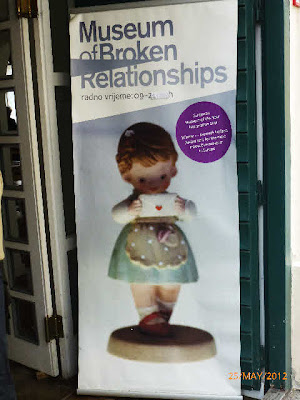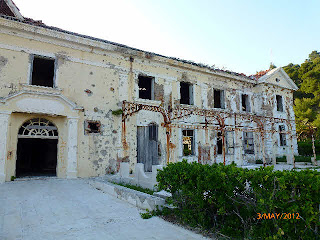The cathedral was virtually rebuilt in 1880 following an
earthquake and is very elegant, but doesn’t take a nice photo at the moment as
it’s covered in scaffolding- because it’s being restored!
So
this is St Mark’s church instead. It has a roof featuring the coats of arms of
Zagreb and Croatia. These could be mistaken for the local football teams’
crests put there by celebrating fans. It’s in a lovely cobbled square that also
contains the Croatian Parliament building. Opposite the cathedral is a set of statues in gold leaf of the Madonna and four angels. The gold is so bright it looks like the photo’s been touched up. Sculptures are from the mid 1800’s by an Austrian called Fenkhorn.
The market is a huge affair and deals in the usual
range of fresh veg and clothes. Around the market are numerous cafes containing
many characters who are much more interesting to photograph than the onions and
cabbage. The next photo is of a true Father Christmas face, but the chap behind
is worth a look as he seems to be practicing for his next gurning competition.
The Croatian National Theatre is an example of the many
splendid buildings dating from the 19th and early 20th
centuries. It was opened in 1895, and as we walked along the far side we could
hear some opera singers practicing. The mustard colour was quite popular in the
city but maybe makes it look too much like a concert hall at the end of the
pier.
There are many areas of green space, usually with a
feature of some sort, perhaps a bandstand, a public building or a sculpture as
in the next photo. It’s a modern work, and by the figure’s dimensions is
clearly a warning to all against too much junk food.
Being the capital, there are numerous museums, one of
which we had never encountered before: the Museum of Broken Relationships. We
didn’t go in as time was limited, but I couldn’t help Googling it later to find
out what it contained. Apparently anything from garden gnomes to underpants!
“This is the vase she threw at Henry before she walked out” type of thing.
Notice the sign is in English, so maybe they're targeting the UK divorce rate.

Zagreb feels like a city coming out of a recession
(whilst the rest of us are heading into one!). The Homeland War is well behind
them and Croatia joins the European Community next year. However, the legacy of
the communist regime is still visible in this typical scene of Zagreb’s pretty
rooftops from the high town. If you look along the skyline there are masses of
utilitarian highrise flats. We passed them on the train into the city. The
closer you get, the grimmer they look. But if you’ve nowhere to go, or live in some hovel,
then they’d look great, so perhaps we shouldn’t be so quick to pass judgement.

The train journey mentioned above was comfortable and
cheap. The station was a 10 minute walk from the campsite, so very convenient
and much less stressful than driving the 40 miles to Zagreb. It was a corridor
train with compartments, so have a look at the photo and try to recall when you
last rode in one of these. Remember the luggage racks you could sleep on?




















































